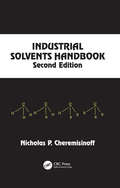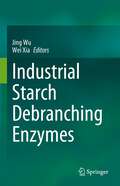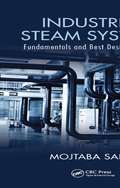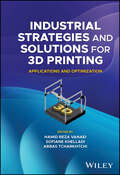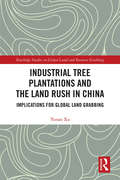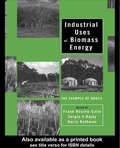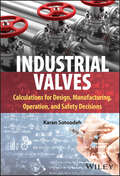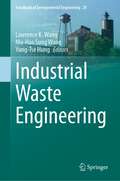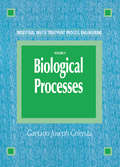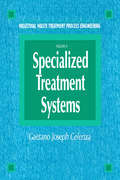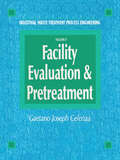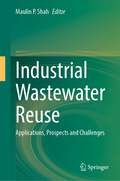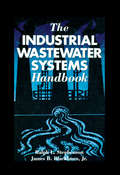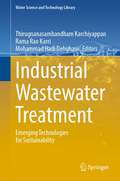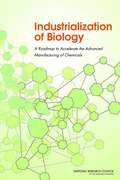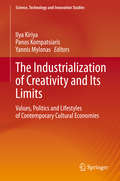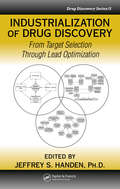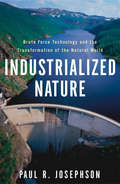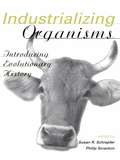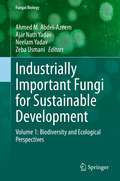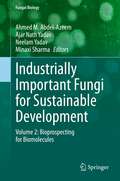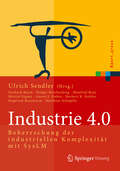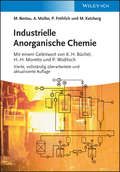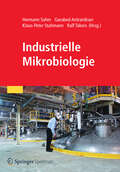- Table View
- List View
Industrial Solvents Handbook, Revised And Expanded
by Nicholas P. CheremisinoffKeeping pace with current trends in solvent production, this volume builds upon its previous edition with broader coverage of safe handling practices, health effects, physical properties, and chemical synthesis routes to some of the most important organic solvents used in the chemical and allied process industries. This handy reference features a glossary of solvent terminology and an easy-to-reference index of synonyms for chemicals and solvents. The Second Edition features new and updated chapters on the major classes of organic solvents, descriptions for general use, and the chemical formulation, thermodynamic properties, health and toxicity, and combustible characteristics of solvents.
Industrial Starch Debranching Enzymes
by Jing Wu Wei XiaThe book presents a systematic and detailed introduction on starch debranching enzymes concerning the classification, biochemical properties, features on sequences and structures, enzyme engineering, production, and current applications. All relevant contents are organized to focus on characteristics, productions and industrial applications of the starch debranching enzymes. It is purposed to deepen the understandings on the pre-existing researches, developments, and bottlenecks, and also to discuss the research hotspots and application perspectives of starch debranching enzymes. The book is written for researchers, professional/practitioners and graduate students in the field of enzymology, microbiology, and food science etc.
Industrial Steam Systems: Fundamentals and Best Design Practices
by Mojtaba SabetThis clear, easy-to-follow handbook is a useful resource for engineers, architects, and plant operators. A one-stop reference for beginners and advanced readers alike, it describes industrial steam systems design and operation in simple steps. The book explains the system fundamentals, system setup, and required equipment, building, mechanical, and other code requirements, and details the execution of a sample project. It also explains the equipment operation principle and describes best design practices for system setup, piping and instrumentation, equipment sizing, pipe sizing, and equipment selection.
Industrial Strategies and Solutions for 3D Printing: Applications and Optimization
by Hamid Reza Vanaei Sofiane Khelladi Abbas TcharkhtchiINDUSTRIAL STRATEGIES AND SOLUTIONS FOR 3D PRINTING Multidisciplinary, up-to-date reference on 3D printing from A to Z, including material selection, in-process monitoring, process optimization, and machine learning Industrial Strategies and Solutions for 3D Printing: Applications and Optimization offers a comprehensive overview of the 3D printing process, covering relevant materials, control factors, cutting-edge concepts, and applications across various industries such as architecture, engineering, medical, jewelry, footwear, and industrial design. While many published books and review papers have explored various aspects of 3D printing, they often approach the topic from a specific perspective. This book instead views 3D printing as a multidisciplinary field, extending beyond its rapid growth into emerging areas like data science and artificial intelligence. Written by three highly qualified academics with significant research experience in related fields, Industrial Strategies and Solutions for 3D Printing: Applications and Optimization includes information on: Role of various 3D printing features in optimization and how machine learning can be used to further enhance optimization processes Specific optimization techniques including physico-chemical, mechanical, thermal, and rheological characteristics Steps for transitioning of 3D printing from the laboratory scale to industrial applications in fields such as biology, turbomachinery, automotive, and aerospace Challenges related to the controlling factors for in the optimization purpose, along with in-process monitoring of 3D printing for optimal results and output Industrial Strategies and Solutions for 3D Printing: Applications and Optimization is a valuable and up-to-date reference on the subject for researchers, scholars, and professionals in biomedical, chemical, and mechanical engineering seeking to understand foundational concepts related to the free-form fabrication approach and how to achieve optimal results.
Industrial Tree Plantations and the Land Rush in China: Implications for Global Land Grabbing (Routledge Studies in Global Land and Resource Grabbing)
by Yunan XuThis book analyses the political and economic causes, mechanisms and impacts of the industrial tree plantation boom in China. In the past two decades, the industrial tree plantation sector has been expanding rapidly in China, especially in Guangxi Province. Based on extensive primary data, this book concentrates on the political economy of the sector’s expansion with a focus on the recent and dramatic agrarian transformation involving the land-labour nexus, the impact on villagers’ livelihoods, the role of the state, and political reactions from below. The book questions the stereotypical portrayal of local communities as the excluded villager. Instead, it demonstrates that this is a much more complex issue with varying levels of passive and active forms of inclusion and exclusion within local communities. While most literature focuses on crop booms for food and biofuel production the industrial plantation sector has largely been overlooked, despite it being one of the biggest sectors in the current rush for land. Filling this lacuna, this book also reveals that while China has traditionally been painted as a major land grabber and consumer of crop booms it is also a destination of foreign investment. In doing so the book highlights how large-scale foreign land deals can also take place in traditional ‘grabber’ countries like China which feeds into the wider debates about global land politics and resource grabbing. This book will be of great interest to students and scholars of land grabbing, rural development and agrarian transformations, as well as Chinese development.
Industrial Uses of Biomass Energy: The Example of Brazil
by Frank Rosillo-Calle Sergio V. Bajay Harry RothmanIndustrial Uses of Biomass Energy demonstrates that energy-rich vegetation, biomass, is a key renewable energy resource for the future. Brazil, uniquely, has a recent history of large-scale biomass industrial uses that makes it a specially important test-bed both for the development of biomass technology and its utilisation, and for understanding h
Industrial Valves: Calculations for Design, Manufacturing, Operation, and Safety Decisions
by Karan SotoodehINDUSTRIAL VALVES Improve the design and safety of your industrial valves with this comprehensive guide Industrial valves are used to regulate the flow of liquids, gases, or slurries. They are fundamental to multiple industries, including marine shipping, in which valves regulate power supply, wastewater, water for fire-fighting, and other shipboard essentials. They are also critical to the oil and gas industry, where valves are used to control the flow of oil or gas out of deposits, direct the crude oil refining process, protect key areas and equipment from spillage and overflow, and more. Without the safety and regulating power provided by industrial valves these industries could not proceed. This book provides a thorough introduction to the modeling and calculation of key challenges related to valve design, manufacturing, and operation. It focuses particularly on solving problems of material failure due to corrosion and cavitation, allowing readers to construct valve designs that will maximize safety and reliability. It is a critical resource in helping protect workplaces, industrial sites, and valuable equipment from the externalities of these fundamental industrial resources. Readers will also find: Applied calculations based on real-life cases from industry Information based on international standards including NORSOK (Norwegian standard) and IECs (European standards) Based on decades of experience in the relevant industries Industrial Valves is a useful reference for engineers and practitioners in the oil and gas and marine industries, piping engineers, valve manufacturers, and more.
Industrial Waste Engineering (Handbook of Environmental Engineering #28)
by Lawrence K. Wang Mu-Hao Sung Wang Yung-Tse HungThis volume discusses: (1) the treatment of hazardous sludge, wastewater, textile effluent, contaminated groundwater, laboratory waste, toxic dye, heavy metals, acid mine drainage and palm oil effluent; (2) the technologies of stabilization, solidification, natural coagulation-flocculation, river catchment control and mitigation, dredging and mining operations, and (3) the management of acid mines, laboratories, nano pollutants and plant effluents.
Industrial Waste Treatment Process Engineering: Biological Processes, Volume II
by Gaetano CelenzaIndustrial Waste Treatment Process Engineering is a step-by-step implementation manual in three volumes, detailing the selection and design of industrial liquid and solid waste treatment systems. It consolidates all the process engineering principles required to evaluate a wide range of industrial facilities, starting with pollution prevention and source control and ending with end-of-pipe treatment technologies.Industrial Waste Treatment Process Engineering guides experienced engineers through the various steps of industrial liquid and solid waste treatment. The structure of the text allows a wider application to various levels of experience. By beginning each chapter with a simplified explanation of applicable theory, expanding to practical design discussions, and finishing with system Flowsheets and Case Study detail calculations, readers can "enter or leave" a section according to their specific needs. As a result, this set serves as a primer for students engaged in environmental engineering studies AND a comprehensive single-source reference for experienced engineers. Industrial Waste Treatment Process Engineering includes design principles applicable to municipal systems with significant industrial influents. The information presented in these volumes is basic to conventional treatment procedures, while allowing evaluation and implementation of specialized and emerging treatment technologies.What makes Industrial Waste Treatment Process Engineering unique is the level of process engineering detail. The facility evaluation section includes a step-by-step review of each major and support manufacturing operation, identifying probable contaminant discharges, practical prevention measures, and point source control procedures. This theoretical plant review is followed by procedures to conduct a site specific pollution control program. The unit operation chapters contain all the details needed to complete a treatment process design.
Industrial Waste Treatment Processes Engineering: Specialized Treatment Systems, Volume III
by Gaetano CelenzaIndustrial Waste Treatment Process Engineering is a step-by-step implementation manual in three volumes, detailing the selection and design of industrial liquid and solid waste treatment systems. It consolidates all the process engineering principles required to evaluate a wide range of industrial facilities, starting with pollution prevention and source control and ending with end-of-pipe treatment technologies.Industrial Waste Treatment Process Engineering guides experienced engineers through the various steps of industrial liquid and solid waste treatment. The structure of the text allows a wider application to various levels of experience. By beginning each chapter with a simplified explanation of applicable theory, expanding to practical design discussions, and finishing with system Flowsheets and Case Study detail calculations, readers can "enter or leave" a section according to their specific needs. As a result, this set serves as a primer for students engaged in environmental engineering studies AND a comprehensive single-source reference for experienced engineers. Industrial Waste Treatment Process Engineering includes design principles applicable to municipal systems with significant industrial influents. The information presented in these volumes is basic to conventional treatment procedures, while allowing evaluation and implementation of specialized and emerging treatment technologies.What makes Industrial Waste Treatment Process Engineering unique is the level of process engineering detail. The facility evaluation section includes a step-by-step review of each major and support manufacturing operation, identifying probable contaminant discharges, practical prevention measures, and point source control procedures. This theoretical plant review is followed by procedures to conduct a site specific pollution control program. The unit operation chapters contain all the details needed to complete a treatment process design.Industrial Waste Treatment Process Engineering will interest environmental engineers, chemical process engineers working in environmental engineering, civil engineers with environmental specialties, as well as graduate students in environmental engineering, corporate environmental engineers, plant engineers, and industry and university technical libraries. These books supplement existing texts detailing the regulatory, legal, and permit preparation requirements imposed on manufacturing facilities. Additionally, Industrial Waste Treatment Process Engineering is designed for engineers preparing environmental appropriations for corporate funding and developing systems for plant facilities sensitive to operating costs.
Industrial Waste Treatment Processes Engineering: Facility, Evaluation & Pretreatment, Volume I
by Gaetano CelenzaIndustrial Waste Treatment Process Engineering includes design principles applicable to municipal systems with significant industrial influents. The information presented in these volumes is basic to conventional treatment procedures, while allowing evaluation and implementation of specialized and emerging treatment technologies.What makes Industrial Waste Treatment Process Engineering unique is the level of process engineering detail. The facility evaluation section includes a step-by-step review of each major and support manufacturing operation, identifying probable contaminant discharges, practical prevention measures, and point source control procedures. This theoretical plant review is followed by procedures to conduct a site specific pollution control program. The unit operation chapters contain all the details needed to complete a treatment process design.
Industrial Wastewater Reuse: Applications, Prospects and Challenges
by Maulin P. ShahThis book identifies emerging technologies that allow the reuse and regeneration of industrial wastewater with innovative and applied approaches throughout the wastewater treatment cycle. Today, it is increasingly clear that treated urban wastewater, whose reuse has become an important component of long-term water management worldwide, is a key source of chemical pollutants and emerging biological concerns. Current water-quality guidelines for reclaimed wastewater predominantly address the risks associated with the presence of microbial organisms and chemical parameters such as biological oxygen demand, chemical oxygen demand, E. coli and worms, and in some cases heavy metals; however, they are insufficient for the full evaluation of risks. The global growth of population is concentrated in urban areas; therefore, most of the challenges and solutions related to wastewater reside in urban treatment plants. Unless wastewater management and wastewater governance processes are significantly improved within a decade, it is likely that our societies will face severe and prolonged water insecurity and urban floods.The application of sustainable technologies can eliminate or minimize micro-contaminants in wastewater. Several organizations focus on the potential impacts to humans and their environments by wastewater reuse. This book gathers new research and reviews work from researchers and scientists to identify the main barriers and limitations that will need to be overcome, so that wastewater reuse strategies gain more momentum and will be adopted more efficiently worldwide.The book is designed for engineers, scientists, and other professionals who are seeking an excellent introduction to and basic knowledge of the principles of environmental bioremediation technologies.
The Industrial Wastewater Systems Handbook
by Ralph L. Stephenson James B. Blackburn, Jr.From explanations of laws and regulations to hands-on design and operation-the Handbook has it covered!
Industrial Wastewater Treatment: Emerging Technologies for Sustainability (Water Science and Technology Library #106)
by Thirugnanasambandham Karchiyappan Rama Rao Karri Mohammad Hadi DehghaniThis book provides an overview of recent advances in technologies for water treatment processes, such as green technology, nano-adsorbents, photocatalysts, advanced oxidation, membranes separation and sustainable technologies. Advances in membrane technology and fabrication process is presented in detail. Latest approaches like microbial treatment, electro chemical and solar energy-based treatment techniques were presented. Also, the use of sustainable and energy efficient approaches were discussed.· The book presents the negative impact of inorganic and organic pollutants on the natural environment and human health. It describes and discussing the advanced membrane technologies, novel green adsorbents, microbial treatment techniques, electro chemical and solar based removal techniques It also compares the most effective methods of removing toxic contaminants from water solutions with the use of sustainable and energy efficient approaches It also presents the life cycle assessment of emerging technologies in industrial wastewater treatment and desalination as well as presents the benchmarking of energy efficiency during treatment process
Industrialization of Biology: A Roadmap to Accelerate the Advanced Manufacturing of Chemicals
by Committee on Industrialization of Biology: A Roadmap to Accelerate the Advanced Manufacturing of ChemicalsThe tremendous progress in biology over the last half century - from Watson and Crick's elucidation of the structure of DNA to today's astonishing, rapid progress in the field of synthetic biology - has positioned us for significant innovation in chemical production. New bio-based chemicals, improved public health through improved drugs and diagnostics, and biofuels that reduce our dependency on oil are all results of research and innovation in the biological sciences. In the past decade, we have witnessed major advances made possible by biotechnology in areas such as rapid, low-cost DNA sequencing, metabolic engineering, and high-throughput screening. The manufacturing of chemicals using biological synthesis and engineering could expand even faster. A proactive strategy - implemented through the development of a technical roadmap similar to those that enabled sustained growth in the semiconductor industry and our explorations of space - is needed if we are to realize the widespread benefits of accelerating the industrialization of biology. "Industrialization of Biology" presents such a roadmap to achieve key technical milestones for chemical manufacturing through biological routes. This report examines the technical, economic, and societal factors that limit the adoption of bioprocessing in the chemical industry today and which, if surmounted, would markedly accelerate the advanced manufacturing of chemicals via industrial biotechnology. Working at the interface of synthetic chemistry, metabolic engineering, molecular biology, and synthetic biology, "Industrialization of Biology" identifies key technical goals for next-generation chemical manufacturing, then identifies the gaps in knowledge, tools, techniques, and systems required to meet those goals, and targets and timelines for achieving them. This report also considers the skills necessary to accomplish the roadmap goals, and what training opportunities are required to produce the cadre of skilled scientists and engineers needed.
The Industrialization of Creativity and Its Limits: Values, Politics and Lifestyles of Contemporary Cultural Economies (Science, Technology and Innovation Studies)
by Ilya Kiriya Panos Kompatsiaris Yannis MylonasCreativity loosely refers to activities in the visual arts, music, design, film and performance that are primarily intended to produce forms of affect and social meaning. Yet, over the last few decades, creativity has also been explicitly mobilized by governments around the world as a ‘resource’ for achieving economic growth. The creative economy discourse emphasizes individuality, innovation, self-fulfillment, career advancement and the idea of leading exciting lives as remedies to social alienation. This book critically assesses that discourse, and explores how political shifts and new theoretical frameworks are affecting the creative economy in various parts of the world at a time when creative industries are becoming increasingly ‘industrialized.’ Further, it highlights how work inequalities, oligopolistic strategies, competitive logics and unsustainable models are inherent weaknesses of the industrial model of creativity. The interdisciplinary contributions presented here address the operationalization of creative practices in a variety of geographical contexts, ranging from the UK, France and Russia, to Greece, Argentina and Italy, and examine issues concerning art biennials, museums, DIY cultures, technologies, creative writing, copyright laws, ideological formations, craft production and creative co-ops.
Industrialization of Drug Discovery: From Target Selection Through Lead Optimization (Drug Discovery Series)
by Jeffrey S. HandenThe drug discovery and development process is getting longer, more expensive, and no better. The industry suffers from the same clinical attrition and safety-related market withdrawal rates today as it did 20 years ago. Industrialization of Drug Discovery: From Target Selection Through Lead Optimization scrutinizes these problems in detail, contras
Industrialized Nature: Brute Force Technology and the Transformation of the Natural World
by Paul JosephsonThe construction of the Three Gorges Dam on China's Yangtze River. The transformation of the Amazon into a site for huge cattle ranches and aluminum smelters. The development of Nevada's Yucca Mountain into a repository for nuclear waste. The extensive irrigation networks of the Grand Coulee and Kuibyshev Dams. On the face of it, these massive projects are wonders of engineering, financial prowess, and our seldom-questioned ability to modify nature to suit our immediate needs. For nearly a century we have relied increasingly on science and technology to harness natural forces, but at what environmental and social cost?In Industrialized Nature, historian Paul R. Josephson provides an original examination of the ways in which science, engineering, policy, finance, and hubris have come together, often with unforeseen consequences, to perpetuate what he calls "brute-force technologies"--the large-scale systems created to manage water, forest, and fish resources. Throughout the twentieth century, nations with quite different political systems and economic orientations all pursued this same technological subjugation of nature. Josephson compares the Soviet Union's heavy-handed efforts at resource management to similar projects undertaken in the United States, Norway, Brazil, and China. He argues that brute-force technologies require brute-force politics to operate. He shows how irresponsible--or well-intentioned but misguided--large-scale manipulation of nature has resulted in resource loss and severe environmental degradation.Josephson explores the ongoing industrialization of nature that is happening in our own backyards and around the world. Both a cautionary tale and a call to action, Industrialized Nature urges us to consider how to develop a future for succeeding generations that avoids the pitfalls of brute-force technologies.
Industrializing Organisms: Introducing Evolutionary History (Hagley Perspectives on Business and Culture #Vol. 5)
by Susan R. Schrepfer Philip ScrantonFirst Published in 2004. Routledge is an imprint of Taylor & Francis, an informa company.
Industrially Important Fungi for Sustainable Development: Volume 1: Biodiversity and Ecological Perspectives (Fungal Biology)
by Ahmed M. Abdel-Azeem Ajar Nath Yadav Neelam Yadav Zeba UsmaniFungi are an understudied, biotechnologically valuable group of organisms. Due to their immense range of habitats, and the consequent need to compete against a diverse array of other fungi, bacteria, and animals, fungi have developed numerous survival mechanisms. However, besides their major basic positive role in the cycling of minerals, organic matter and mobilizing insoluble nutrients, fungi have other beneficial impacts: they are considered good sources of food and active agents for a number of industrial processes involving fermentation mechanisms as in the bread, wine and beer industry. A number of fungi also produce biologically important metabolites such as enzymes, vitamins, antibiotics and several products of important pharmaceutical use; still others are involved in the production of single cell proteins. The economic value of these marked positive activities has been estimated as approximating to trillions of US dollars. The unique attributes of fungi thus herald great promise for their application in biotechnology and industry. Since ancient Egyptians mentioned in their medical prescriptions how they can use green molds in curing wounds as the obvious historical uses of penicillin, fungi can be grown with relative ease, making production at scale viable. The search for fungal biodiversity, and the construction of a living fungi collection, both have incredible economic potential in locating organisms with novel industrial uses that will lead to novel products. Fungi have provided the world with penicillin, lovastatin, and other globally significant medicines, and they remain an untapped resource with enormous industrial potential.Volume 1 of Industrially Important Fungi for Sustainable Development provides an overview to understanding fungal diversity from diverse habitats and their industrial application for future sustainability. It encompasses current advanced knowledge of fungal communities and their potential biotechnological applications in industry and allied sectors. The book will be useful to scientists, researchers, and students of microbiology, biotechnology, agriculture, molecular biology, and environmental biology.
Industrially Important Fungi for Sustainable Development: Volume 2: Bioprospecting for Biomolecules (Fungal Biology)
by Ajar Nath Yadav Ahmed M. Abdel-Azeem Neelam Yadav Minaxi SharmaFungi are an essential, fascinating and biotechnologically useful group of organisms with an incredible biotechnological potential for industrial exploitation. Knowledge of the world’s fungal diversity and its use is still incomplete and fragmented. There are many opportunities to accelerate the process of filling knowledge gaps in these areas. The worldwide interest of the current era is to increase the tendency to use natural substances instead of synthetic ones. The increasing urge in society for natural ingredients has compelled biotechnologists to explore novel bioresources which can be exploited in industrial sector. Fungi, due to their unique attributes and broad range of their biological activities hold great promises for their application in biotechnology and industry. Fungi are an efficient source of antioxidants, enzymes, pigments, and many other secondary metabolites. The large scale production of fungal pigments and their utility provides natural coloration without creating harmful effects on entering the environment, a safer alternative use to synthetic colorants. The fungal enzymes can be exploited in wide range of industries such as food, detergent, paper, and also for removal toxic waste. This book will serve as valuable source of information as well as will provide new directions to researchers to conduct novel research in field of mycology.Volume 2 of “Industrially Important Fungi for Sustainable Development” provides an overview to understanding bioprospecting of fungal biomolecules and their industrial application for future sustainability. It encompasses current advanced knowledge of fungal communities and their potential biotechnological applications in industry and allied sectors. The book will be useful to scientists, researchers, and students of microbiology, biotechnology, agriculture, molecular biology, and environmental biology.
Industrie 4.0: Beherrschung der industriellen Komplexität mit SysLM
by Ulrich SendlerDie nächste Stufe der industriellen Entwicklung, Industrie 4.0, erfordert die Beherrschung multidisziplinärer Entwicklung und Produktion komplexer, intelligenter Systeme. Unsere Industrie ist darauf nicht vorbereitet. Organisation, Prozesse, Management - alles ist ausgerichtet auf Produkte mit nur geringem Softwareanteil. Die Unternehmenslenker müssen ganzheitliche Strategien entwickeln. Eine einfache Verbesserung einzelner Teile des Unternehmens reicht nicht aus. Neben einer allgemeinen Analyse der Situation und der daraus resultierenden Herausforderungen kommen herausragende Vertreter aus Wirtschaft und Wissenschaft zu Wort, die das Thema aus ihrer jeweiligen Sicht beleuchten.
Industrielle Anorganische Chemie
by Martin Bertau Armin Müller Peter Fröhlich Michael Katzberg Karl Heinz Büchel Hans-Heinrich Moretto Dietmar WernerMit einem neuen Herausgeberteam wird das Buch "Industrielle Anorganische Chemie" grundlegend überarbeitet weitergeführt. Das Lehrwerk bietet in hervorragend übersichtlicher, knapp und präzise gehaltener Form eine aktuelle Bestandsaufnahme der industriellen anorganischen Chemie. Zu Herstellungsverfahren, wirtschaftlicher Bedeutung und Verwendung der Produkte, sowie zu ökologischen Konsequenzen, Energie- und Rohstoffve brauch bieten die Autoren einen fundierten Überblick. Hierfür werden die bewährten Prinzipien hinsichtlich der Beiträge von Vertretern aus der Industrie sowie des generellen Aufbaus beibehalten. Inhaltlich werden Neugewichtungen vorgenommen: l Aufnahme hochaktueller Themen wie Lithium und seine Verbindungen und Seltenerdmetalle l Aufnahme bislang vernachlässigter Themen wie technische Gase, Halbleiter- und Elektronikmaterialien, Hochofenprozess sowie Edelmetalle l Straffung aus industriell-anorganischer Sicht weniger relevanter Themen z.B. in den Bereichen Baustoffe oder Kernbrennstoffe l Ergänzungen in der Systematik hinsichtlich bislang nicht behandelter Alkali- und Erdalkalimetalle und ihre Bedeutung in der industriellen anorganischen Chemie l Betrachtung der jeweiligen Rohstoffsituation Begleitmaterial für Dozenten verfügbar unter: www.wiley-vch.de/textbooks "Von den Praktikern der industriellen Chemie verfasst, füllt dieser Band eine Lücke im Fachbuchangebot. Das Buch sollte von jedem fortgeschrittenen Chemiestudenten und auch von Studierenden an Fachhochschulen technischchemischer Richtungen gelesen werden. Dem in der Industrie tätigen Chemiker schließlich bietet es einen lohnenden Blick über den Zaun seines engen Arbeitsgebietes.... Die Autoren haben ein Buch vorgelegt, dem man eine weite Verbreitung wünschen und vorhersagen kann." GIT "Das Buch kann uneingeschränkt empfohlen werden." Nachrichten aus Chemie Technik und Laboratorium "sein besonderer Wert liegt in der anschaulichen Darstellung und in der Verknüpfung technischer und wirtschaftlicher Fakten." chemie-anlagen + verfahren
Industrielle Mikrobiologie
by Hermann Sahm, Garabed Antranikian, Klaus-Peter Stahmann and Ralf TakorsDie Industrielle Mikrobiologie vereint das Fachwissen von Naturwissenschaftlern und Ingenieuren über die Nutzung von Bakterien und Pilzen. Als innovative Querschnittsdisziplin bietet sie wichtige Voraussetzungen für die Entwicklung konkurrenzfähiger Produkte auf der Basis umweltschonender Verfahren. So setzt z.B. die chemische Industrie heute bereits Mikroorganismen in Prozessen ein, um Rohstoffe und Energie sparen. In dieser Branche besteht ein zunehmender Bedarf an gut ausgebildeten Fachkräften.Dieses neue Lehrbuch wurde von erfahrenen Wissenschaftlern aus Hochschulen und der Industrie verfasst. Es soll Studierende aus Life Science-Bachelorstudiengängen sowie fortgeschrittene Studierende der Chemie oder der Ingenieurwissenschaften in die Industrielle Mikrobiologie einführen. Es vermittelt die Grundlagen der Entwicklung von Produktionsstämmen und erklärt spezielle Verfahren zur Herstellung mikrobieller Produkte. Dabei wird aufgezeigt, wie das Potential der Mikroorganismen optimal genutzt werden kann.Zunächst wird ein Überblick über die geschichtliche Entwicklung der Industrielle Mikrobiologie und eine Einführung in die Bioverfahrenstechnik gegeben. Anschließend werden in 10 Kapiteln ausgewählte mikrobielle Verfahren zur Herstellung von Lebensmitteln, organischen Säuren, Alkoholen, Aminosäuren, Vitaminen, Antibiotika, Pharmaproteinen, Enzymen, Biopolymeren sowie Steroiden und Aromastoffen beschrieben. Im letzten Kapitel wird am Beispiel der biologischen Abwasserreinigung aufgezeigt, dass die Mikroorganismen nicht nur ein enormes Synthese-, sondern auch ein großes Abbaupotential besitzen, mit dem sie einen Beitrag zu den Stoffwechselkreisläufen auf unserer Erde leisten.Die Autoren wünschen sich, dass dieses Lehrbuch das Interesse vieler Studierender an diesem spannenden Lehr- und Forschungsgebiet weckt und sie daraus Nutzen ziehen können, um dann selbst zur weiteren Entwicklung der Industriellen Mikrobiologie beizutragen.
Industrielle Mikrobiologie
by Klaus-Peter Stahmann Garabed Antranikian Ralf Takors Hermann SahmDie Industrielle Mikrobiologie vereint das Fachwissen von Naturwissenschaftlern und Ingenieuren über die Nutzung von Bakterien und Pilzen. Als innovative Querschnittsdisziplin bietet sie wichtige Voraussetzungen für die Entwicklung konkurrenzfähiger Produkte auf der Basis umweltschonender Verfahren. So setzt z.B. die chemische Industrie heute bereits Mikroorganismen in Prozessen ein, um Rohstoffe und Energie sparen. In dieser Branche besteht ein zunehmender Bedarf an gut ausgebildeten Fachkräften. Dieses neue Lehrbuch wurde von erfahrenen Wissenschaftlern aus Hochschulen und der Industrie verfasst. Es soll Studierende aus Life Science-Bachelorstudiengängen sowie fortgeschrittene Studierende der Chemie oder der Ingenieurwissenschaften in die Industrielle Mikrobiologie einführen. Es vermittelt die Grundlagen der Entwicklung von Produktionsstämmen und erklärt spezielle Verfahren zur Herstellung mikrobieller Produkte. Dabei wird aufgezeigt, wie das Potential der Mikroorganismen optimal genutzt werden kann. Zunächst wird ein Überblick über die geschichtliche Entwicklung der Industrielle Mikrobiologie und eine Einführung in die Bioverfahrenstechnik gegeben. Anschließend werden in 10 Kapiteln ausgewählte mikrobielle Verfahren zur Herstellung von Lebensmitteln, organischen Säuren, Alkoholen, Aminosäuren, Vitaminen, Antibiotika, Pharmaproteinen, Enzymen, Biopolymeren sowie Steroiden und Aromastoffen beschrieben. Im letzten Kapitel wird am Beispiel der biologischen Abwasserreinigung aufgezeigt, dass die Mikroorganismen nicht nur ein enormes Synthese-, sondern auch ein großes Abbaupotential besitzen, mit dem sie einen Beitrag zu den Stoffwechselkreisläufen auf unserer Erde leisten. Die Autoren wünschen sich, dass dieses Lehrbuch das Interesse vieler Studierender an diesem spannenden Lehr- und Forschungsgebiet weckt und sie daraus Nutzen ziehen können, um dann selbst zur weiteren Entwicklung der Industriellen Mikrobiologie beizutragen.
